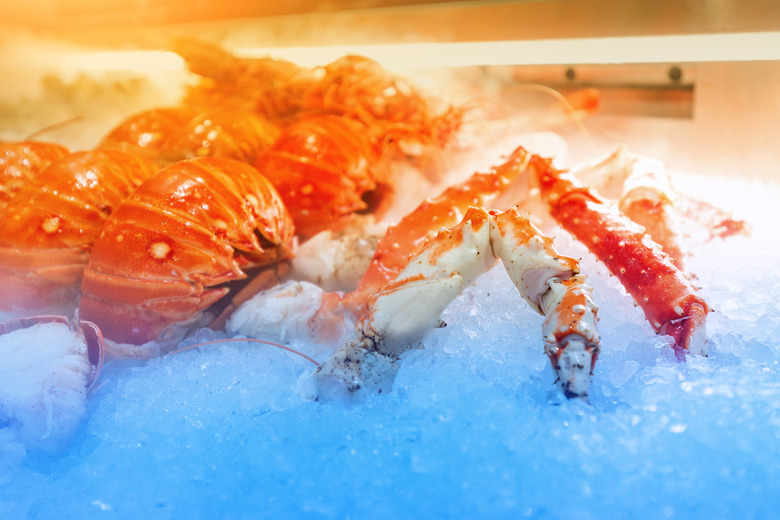Types Of Crab In Alaska
Alaska is a state in the United States that borders the northeastern side of Canada. Due to its proximity to the Arctic Circle, Alaska has long summer days when the sun never goes down and dark winters when the sun rarely appears. Alaska has approximately 6,640 miles (10,686 kilometers) of coastline and oceanic waters and sea ice heavily influence the climate. With all this coastline, there are many species of Alaska crabs that make these oceans their home.
Read more about how crabs adapt to its environment.
Alaskan King Crabs
Alaskan King Crabs
King crabs are found across the world all the way from New Zealand to Russia. Alaska is in the range for three king crab species: red king crabs (Paralithodes camtschaticus), blue king crabs (P. platypus) and golden king crabs (Lithodes aequispinus). Red and blue king crabs live along coastlines to 200 yards deep (183 meters). Golden king crabs usually live from 200 yards down to 800 yards (731 meters).
Like other crabs, king crabs need to shed their calcium exoskeleton to grow. King crabs frequently molt until they hit sexual maturity around four to five years of age. Once they are adults, they may only molt once a year or every two years. The most gigantic king crabs are estimated to be between 20 and 30 years old, weighing up to 24 pounds (10.9 kilograms) with a leg span of five feet (1.5 meters).
Tanner Crab (Chionoecetes bairdi)
Tanner Crab (Chionoecetes bairdi)
The Tanner crab and the Bering Sea snow crab (C. Opilio) are similar species referred to as true crabs because they have eight legs for walking and two pincers. Their range spans the eastern North Pacific Ocean and the Bering Sea. From the age of seven to eleven, commercial sized tanner crabs are a bit smaller with males typically weighing between 1 and 2 pounds (0.454 to 0.9 kilograms) while the Bering Sea crabs reach 2 to 4 pounds (0.9 and 1.8 kilograms).
Females incubate between 85,000 and 424,000 eggs for a whole year before laying them to hatch during the spring plankton bloom. Larvae swim for up to 66 days before settling on the bottom. These crabs also molt regularly before reaching sexual maturity at five years old for females and six years old for males. Their lifespan can reach 14 years of age.
Dungeness Crab (Metacarcinus magister)
Dungeness Crab (Metacarcinus magister)
The Dungeness crab lives along estuaries and shorelines with a range spanning from Magdalena Bay in Mexico to the Aleutian Islands. It takes four to five years for the Dungeness to reach legal catch limit size of 6.5 inches (16.51 centimeters) with their maximum size being around 10 inches (25.4 centimeters). At legal catch size, the Dungeness will be between 2 and 3 pounds (0.9 to 1.36 kilograms).
Read more about what type of habitats crabs live in.
Dungeness crabs live between eight and 13 years. Males can only mate with females shortly after they have molted. Females can store sperm for up to two years, enabling them to reproduce without the need for molting and mating.
Large females can carry around 2.5 million eggs at any one time. Juvenile Dungeness crabs spend four months as planktonic zoea larvae before beginning the molting process until they reach sexual maturity at three years of age.
Crab Fishing
Crab Fishing
Crab fishing is essential in Alaska with king crab fishing historically being the most important fishery after sockeye salmon (Oncorhynchus nerka). Crabs are caught using pots baited with fish that are sunk to the ocean floor and await crabs to enter.
Rough seas, heavy pots, coils of line and workers on for long shifts make being a crab fisherman a potentially dangerous job. Because of historical overfishing and poor recruitment years of juvenile king crabs, quota systems are now in place to manage the populations and help increase populations.
Another way governments manage populations and help prevent overfishing is through applying crab seasons in which people can only catch that crab species during the season. For example, in 2018 the Bering Sea crab season ran from October 15, 2018 to May 15, 2019.
As well as making a season when people can catch crabs, location restrictions for where you can collect crabs from have been put in place. Additionally, fishermen must apply for a quota which states their total allowable catch they are permitted for the season.
References
- Alaska Fishing Jobs Network: Types of Alaska Crab
- Alaska Department of Fish and Game: Alaska King Crabs
- Alaska Department of Fish and Game: Red King Crab
- Alaska Department of Fish and Game: Bering Sea Snow Crab Season Opens News Release
- Alaska Department of Fish and Game: Dungeness
- Alaska Department of Fish and Game: Tanner Crabs
- National Oceanic and Atmospheric Information: Stock Assestment and Fishery Evaluation Report for the King and Tanner Crab Fisheries of the Gulf of Alaska and Bering Sea/Aleutian Islands Area : Economic Status of the BSAI King and Tanner Crab Fisheries off Alaska, 2017
Cite This Article
MLA
Jerrett, Adrianne. "Types Of Crab In Alaska" sciencing.com, https://www.sciencing.com/types-crab-alaska-7821009/. 22 November 2019.
APA
Jerrett, Adrianne. (2019, November 22). Types Of Crab In Alaska. sciencing.com. Retrieved from https://www.sciencing.com/types-crab-alaska-7821009/
Chicago
Jerrett, Adrianne. Types Of Crab In Alaska last modified March 24, 2022. https://www.sciencing.com/types-crab-alaska-7821009/
